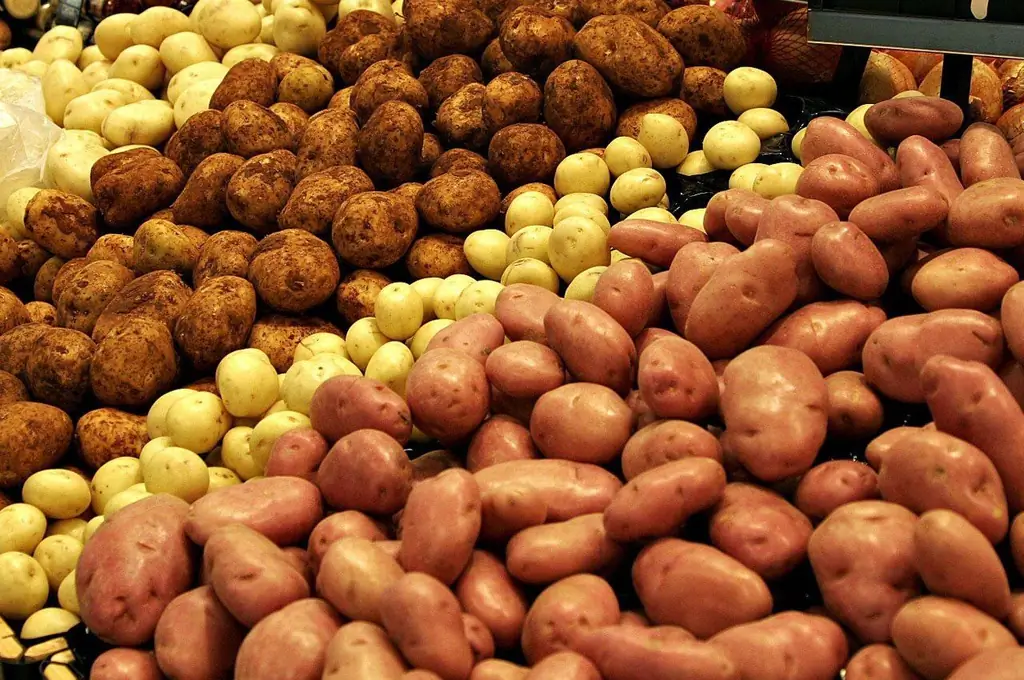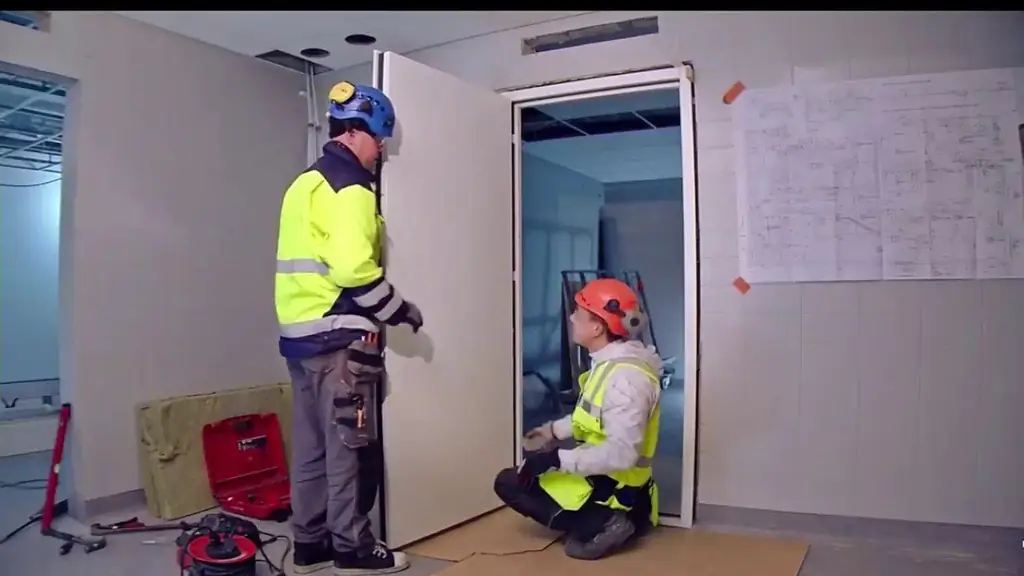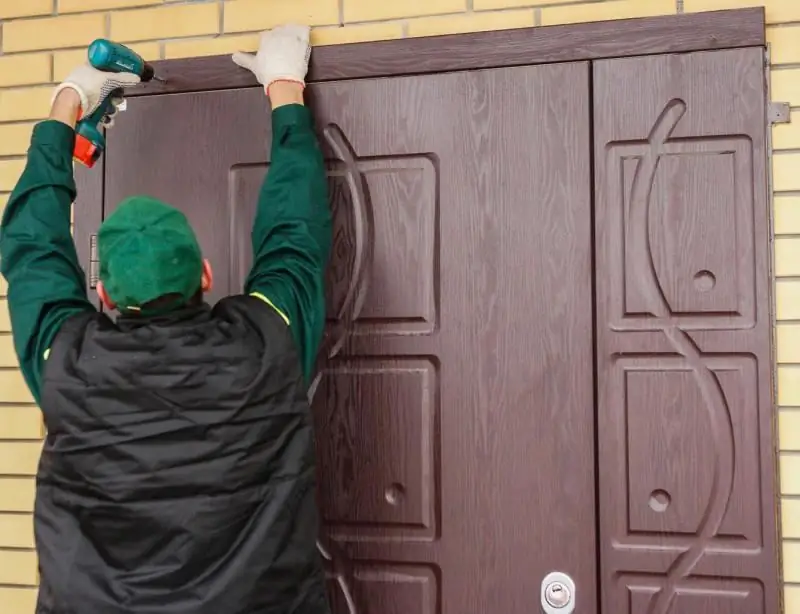
Table of contents:
- How to organize storage of potatoes in winter so that they lie until spring
- Modes for potato tubers
- Preparing potatoes for storage at home
- How to store a vegetable correctly
- Container
- Methods for storing potatoes in a basement or cellar
- Features of different varieties of vegetables
- Potato storage errors and related diseases
- What to do with the old
- Video tip for zealous owners
- Author Bailey Albertson [email protected].
- Public 2024-01-17 22:26.
- Last modified 2025-06-01 07:32.
How to organize storage of potatoes in winter so that they lie until spring

Potatoes are the most favorite vegetable in our latitudes, which is also deservedly called "the second bread". It is boiled, fried, stewed, baked, soups, stews are prepared with it, and even used as a filling for pies. Most of the potatoes are starches, which is why they are quite high in calories. Also contains a full set of beneficial trace elements, vitamins and amino acids. Its benefits to the body are determined not only by the methods of preparation, but also by the conditions and duration of storage. Often potatoes rot, are affected by fungal diseases, become lethargic and germinate. In order for potatoes to be successfully stored at home all winter, temperature conditions and other nuances must be observed.
Content
- 1 Modes for potato tubers
-
2 Preparing potatoes for storage at home
2.1 Preparing potatoes for long-term storage - photo
-
3 How to store a vegetable correctly
- 3.1 How to make an insulated box
- 3.2 How to make an insulated heated box
- 3.3 How to make a box for storing vegetables on the balcony
-
4 Container
4.1 The most common container for storing potatoes - photo
-
5 Methods for storing potatoes in a basement or cellar
- 5.1 How you can save the crop: methods in the photo
- 5.2 Where to keep stock
- 6 Features of different varieties of vegetables
-
7 Potato storage errors and related diseases
7.1 Potato diseases that arise due to storage errors - photo
- 8 What to do with the old
- 9 Video tip for zealous owners
Modes for potato tubers
- The treatment period. Drying and ripening of tubers occurs, healing of cuts and injuries from blows. After digging up the potatoes, it is recommended to leave to lie for 1-2 hours. During this time, it dries out enough and becomes covered with a dry crust. Long harvest in the sun is not worth it, because under the influence of direct sunlight, the tubers turn green and can get "sunburn". Then the potatoes are harvested and transferred under a shed for 1-2 weeks, where they lie in one layer. During this time, the protective properties of the tubers are strengthened, making them ready for the next stage. The ideal air temperature for this period is + 13 … + 18oС.
- Cooling period. It consists in a gradual decrease in temperature to + 2 … + 4o. Lasts 10-15 days. During this period, the tubers enter a dormant period. In ordinary summer cottages, nature itself will help to achieve this effect, since in the autumn period there is a natural cooling of the air.
- The main period or winter. Lasts until the end of February. For long-term storage, potatoes are transferred to a suitable place for this. In order not to disturb the state of rest, they provide the correct temperature, humidity and light conditions.
- Spring period. It starts with the onset of warm weather. The temperature in the potato storage rises and the tubers begin to sprout. From this point on, the potatoes quickly lose their usefulness.
Sometimes the first two periods are combined into one post-harvest period. It is a preparatory stage before long-term storage. Failure to observe it, you are in danger of losing a significant part of the harvest. It is also important to protect the potatoes from moisture and rain during this time.
Preparing potatoes for storage at home
After the correct post-harvest preparation, the potatoes are almost ready for long-term storage. It remains only to sort it, examine it for the presence of diseased tubers and remove dried dirt.
If we have harvested our own crop and plan to plant potatoes next year, then first of all we need to select the potatoes for sowing. As a rule, for this they take the smallest tubers, green potatoes, as well as tubers with many eyes (more than 6 eyes). Naturally, damaged and diseased tubers are not suitable
Unlike "food" potatoes, it is recommended to leave seed potatoes in the sun for several days to "green". Thanks to this, the potatoes will last longer, and will also become inedible for rodents.
- Potato tubers are sorted depending on the variety and purpose. There are varieties for long-term storage (late and mid-season), and there are early ones, which lie at the maximum until winter. It is necessary to take into account the purpose of the tubers: there are potatoes, which boil quickly and are suitable for mashed potatoes, and there are more "harder" varieties ideal for frying.
- You can also sort by size. Large tubers last longer than small tubers. In addition, potatoes that are about the same size create more voids for better ventilation.
- Much attention should be paid to the quality of the tubers. In the future, all cuts and poorly healed injuries can cause rot. Such potatoes are selected "for now". Cuts can be treated with wood ash.
- It is recommended to wash potato tubers before storage, since many microbes live in the ground that can provoke the development of diseases. It is not always possible to do this, especially if there are a lot of potatoes. In normal cases, the dirt itself falls off after drying in the process of natural friction, when the crop is folded in boxes or bags. You can also remove it during sorting by wearing gloves with a rough surface. Potatoes are not washed immediately after digging.
- After sorting, the potatoes are put into containers and sent for storage.
Of course, the quality of tubers, as well as the quality of the entire crop as a whole, will depend on weather conditions, soil, fertilization methods. If summer and autumn were rainy, then there is a high probability of developing rot. Excessive dryness leads to early wilting of tubers. To somehow extend the shelf life of an already bad potato, you can treat it with wood ash. For 20 kg, we need only 2-3 handfuls of ash., Which needs to be poured over the tubers during the laying for storage. Of course, today there are many chemical preparations for protecting potatoes from late blight, rot and other diseases, but it is better to use them when storing seed potatoes, and not potatoes "for food."
To slow down the germination of tubers, it is advised to shift with mint and rowan leaves, pine and spruce branches. These plants contain phytoncides that help prolong the "hibernation".
Preparing potatoes for long-term storage - photo
-

Drying potato tubers after digging - Drying potatoes in the sun is an important preparatory step
-

How to sort potatoes after digging - Sorting potato tubers after digging by size
-

How to sort potatoes - Sorting tubers according to size is an important process for successful long-term storage.
-

Storing potatoes -
Storing potatoes in wooden boxes during the winter
How to store a vegetable correctly
- Temperature. The storage place should be cool - 2-4 ºС heat, at lower temperatures the potatoes lose their taste. The maximum storage temperature is 5-7 ºС. At temperatures of 0 ºС and below, the potatoes freeze, become sweet and unusable, and soon rot.
- Humidity. The optimum humidity is 85-90%. Low and excessive humidity is equally harmful to the preservation of tubers. If the air is too dry, you can put containers with water, the moisture will evaporate and humidify the room.
- Shine. Potatoes are stored in the dark. If this is temporary storage on the balcony, then you should cover the container with potatoes in several layers and hide it from direct sunlight.
Not everyone has a suitable place to store potatoes. Often you have to go to some small tricks to ensure optimal conditions and keep the potatoes for as long as possible. If the temperature in the room is too high (for example, in the closet of an ordinary apartment), then you can try to cool the air with ice. To do this, you need plastic bottles with frozen water, which are placed near the potatoes. You can freeze water both in the freezer and on the balcony or outside in frosty weather.
It also happens that the temperature, on the contrary, is too low and there is a risk of freezing the tubers (if stored on an uninsulated balcony). In such cases, you need to think about how and what to insulate. You can wrap the potatoes in old blankets or jackets, or you can make an insulated storage box with your own hands. For especially frosty nights, in order to surely protect vegetables from freezing, it is better to make a heated box.
Before you start manufacturing, you need to decide on the dimensions of the future container.
How to make an insulated box
For the frame, you will need a wooden bar. The finished frame can be sheathed with plywood, chipboard, fiberboard or OSB using self-tapping screws and a screwdriver. Sheets of polystyrene or polystyrene foam, 5 cm thick, are suitable as insulation. Additionally, you can use Izolon. Thermal insulation is glued to the walls and bottom of the box using liquid nails, and the joints are additionally glued with wide tape. The lid is insulated in the same way.
You can also create a box like a nesting doll. You will need two containers, one of which is slightly smaller. The space between the walls is filled with sawdust, crushed foam or other material, 3-5 cm thick.

A foam-insulated potato box is the perfect solution for storing potatoes on the balcony!
How to make an insulated heated drawer
An already finished container can be improved with a heating element and an electrical contact thermostat. A household hair dryer with a low power or two incandescent lamps of 40-60 W are suitable as a heater. The relay will turn on and off the heater automatically, maintaining the desired temperature in the container. A grate should be placed on the bottom of the box to provide a layer of air.
If you decide to use a hair dryer, you will need plastic tubes, 4-5 cm in diameter, through which the heated air will enter the box. Plastic tubes are connected to each other at an angle of 90º. The bottom end is inserted into a hole previously made in the bottom of the container. A hairdryer is attached to the upper end. The heated air will flow to the bottom of the box, rise further and heat its contents. For even heat supply, several holes are made in the lower part of the tube.

Warmed drawer with a household hair dryer
A hairdryer is quite noisy and requires a lot of electricity. Incandescent bulbs can be used instead. In this case, you will need a pipe made of tin into which two bulbs are inserted. The heat they give off will be enough to heat the potatoes.

Thermocontainer heated by incandescent lamps
If you are the lucky owner of an insulated balcony, then for storing vegetables in winter, it will be enough to make an ordinary box made of boards, plywood or other materials.

An example of a box for storing potatoes on an insulated balcony
How to make a box for storing vegetables on the balcony
Container
Potatoes are usually stored in well-ventilated boxes or bags:
- Wooden crates made from planks
- Wooden containers for storing potatoes in the cellar or basement
- Plastic containers with "mesh" walls and bottom
- Boxes made of thick cardboard with holes
- Mesh bags
- Burlap sacks
Potatoes are best stored in small portions, so it is preferable to choose small boxes (10 kg of potatoes) made from wooden planks. They are lightweight, reliable, easy to carry vegetables, and can be stacked on top of one another to save space. In such a container, it is easier to sort out potatoes, it can be viewed through the cracks for the presence of rotten tubers. Thanks to the distance between the slats, air will always flow to the vegetables, and by placing the box on bricks or pallets, you will provide additional ventilation. You can make such a box with your own hands, using unnecessary boards, wooden planks, remnants of lumber and even chipboard, fiberboard and OSB. The optimal width of the slats is 5 cm, the length is 50 cm. You will also need triangular wooden bars for better fixing of the sides. It is best to connect the parts together with nails or self-tapping screws.

DIY wooden box - saving money on buying containers!

Potato storage box drawing
To store potatoes, they also buy plastic boxes, less often metal ones. The plastic container is very light, and the mesh sides and bottom provide good ventilation. As for metal ones, they are much more expensive and heavier; it will not be easy to carry potatoes due to the weight of the boxes themselves. You can store potatoes in large containers made from pallets or the same wooden planks. They are made angular or rectangular. An ordinary rectangular container can be with a horizontal door at the bottom or a chuck. Thanks to this design, potatoes are easy to pick.
It is preferable to choose bags from the net. In such a container, potatoes "breathe" and do not fog up. Strong polypropylene bags are strictly not allowed for long-term storage. They practically do not allow air to pass through and are only suitable for harvesting and transporting it.
Today you can buy a special thermal bag for storing vegetables on the balcony in winter. The top of the bag is made of dense tent fabric, and the inner warm layer is made of thick durable padding polyester. In addition to insulation, such a bag is electrically heated, due to which the temperature inside is maintained within the range of 1-7 ° C even in the most severe frost. Also on sale there are thermal containers, where the temperature is regulated by a special thermal sensor and never drops below 1 ° C. Perhaps the only drawback of such a container is its cost. How to make a heated container with your own hands, we have already described above.
The most common container for storing potatoes - photo
-

Box with wooden boards - The wooden box is the most common container for storing potatoes.
-

Plastic box - Plastic box with mesh bottom and sides
-

Container - Option of a container for storing potatoes in the cellar
-

Corner container - Storing potatoes in a corner container as an alternative to storing in bins
-

Mesh bags - You can store potatoes in brightly colored mesh bags
-

Balcony cellar - The thermal bag is an excellent solution for storing vegetables at low temperatures
Methods for storing potatoes in a basement or cellar
- in bulk right in the middle of the cellar (bulk method)
- in bulk in bins (granary method)
- in large ventilated containers (container)
- small boxes and bags
- on the shelves
Bulk and granary methods do not require packaging, which means you do not need to spend extra money. Their disadvantages are that potatoes are stored in large volumes, and this complicates the process of sorting and inspecting them. The tubers that are in the bottom and middle receive less oxygen. Potatoes in the upper layers often fog up as moisture evaporates and rises from the bottom. To prevent fogging, it is recommended to pour a layer of straw on top, which will absorb excess moisture. The straw should be turned over periodically. You can also store beets with potatoes, the excess moisture of which will only benefit. Vermiculite has good hygroscopicity. It is recommended to fill it in a layer of 3-4 cm. To ensure ventilation in the bins, it is recommended to place pallets on the floor.
If the potatoes are stored in wooden or plastic boxes, the latter should not directly touch the walls and floor (distance 20-30 cm). For proper ventilation, the distance between the rows of boxes should become several centimeters. The disadvantage of this method is that empty boxes take up a lot of space, they need to be washed and disinfected every year.
The bags are placed on the floor in a vertical or horizontal position. With the latter method, the bags can be stacked on top of each other.
Quite a good way to store potatoes on shelves. There it lies in one layer, well ventilated, does not fog up. It is convenient to inspect and sort the tubers; in addition, empty glass jars from winter storage can be placed on empty shelves.
How you can save the harvest: ways in the photo
-

Storing potatoes in bulk - The easiest way to store potatoes
-

How to store potatoes in the cellar - Simple and convenient - storing potatoes in bins
-

How to store potatoes in bags - Storing potatoes in bags horizontally
-

How to store potatoes - Racks are a great solution for storing potatoes!
-

Storing potatoes - Small wooden boxes are the most convenient storage container
Where to keep stock
- Apartment. It is difficult to store large quantities of potatoes in an apartment. A pantry or balcony is better for this. Can be stored in the vestibule if there is space. A few pounds can be stored in a paper bag in the kitchen, ideally in a dark, dry place such as under kitchen cabinets.
- Basement. The crop is ready for storage in the basement after drying and sorting the tubers. But before that, you need to treat the room with a solution of lime and copper sulfate. With the help of a strong solution of potassium permanganate, shelves, stairs, hoods (if any) are cleaned and disinfected. They also use smoke bombs to fumigate the room. Hoods play a very important role in the preservation of potatoes and other vegetables, since a regular supply of air is very important during storage. If your basement is quite warm and the potatoes sprout quickly, you can make additional holes through which cool air can flow from the street. In very cold weather, the holes can be temporarily blocked with unnecessary rags. You can also install a fan.
- Cellar and basement in the garage. If you have a basement in a garage, then the storage conditions and processing of the room will be the same as in a regular basement. In the cellar, potatoes can be stored in bulk if the area allows and there are not very many potatoes. "Gorka" is insulated if there is a fear of freezing.
-
Storing potatoes in a pit. If there is a lot of potatoes, but there is no suitable place for storing it, then it can be stored simply in the garden. We do the following:
- We choose a dry, high place and dig a hole 1.5 m deep and 2 m in diameter.
- We make grooves for the outflow of rain and melt water.
- Put dry straw on the bottom and sides.
- Pour potatoes, not reaching 40-50 cm up.
- Cover the potatoes with straw, on which we put the cuttings of the boards.
- For better evaporation of excess moisture and air exchange on the sides and in the middle, we put vertically sheaves of corn stalks so that they protrude above the pit.
-
We fill the hole with a layer of soil, first by 10 cm, and with the arrival of cold weather by 40-80 cm.

Storing potatoes in a pit A hole in the garden will help preserve the crop when there is a better place
Also, potatoes can be stored in piles, trenches, but such storage methods will be rather temporary.
At home, many people prefer to keep small amounts of potatoes in the refrigerator. This is not entirely correct, since potatoes are on the list of foods that cannot be stored this way. Another common mistake is storing potatoes with other vegetables. Potatoes can be stored with beets and carrots - they absorb moisture well. It is not recommended to store with apples. The latter tend to absorb odors; moreover, the presence of potatoes reduces their shelf life. Also, potatoes are not stored along with zucchini, pumpkin, peppers, onions, garlic and other vegetables.
Features of different varieties of vegetables
The storage time of potatoes is influenced by the amount of starch in its composition. The more starch, the longer it is stored. The most starchy varieties are Lark, Bullfinch, Adretta, Rassvet Kievsky, Charodey, Effect. Such potatoes can lie until spring. Early varieties tend to contain less starch, so they are eaten first. An exception is the Gala variety. Not only is it super early, but it also gives very high yields even in a bad season in bad soil. This variety will appeal to fans of healthy eating due to its low starch content.
Some varieties are generally not suitable for long-term storage. These include the Sineglazka, Lorkh and Dnepryanka varieties.
As for the storage temperature, the varieties Epron, Priekulsky early, Northern rose, Falensky and Berlichingem require a temperature of + 1.5 … + 2 ° С; varieties Ogonyok, Skorospelka, Agrotechnical, Loshitskiy, Temp and Foran are suitable for temperature fluctuations from + 1.5 ° C to + 3 ° C; varieties Start, Lorkh, Razvaristy and Stolovy 19 are best stored at a temperature of + 3 … + 5 ° С.
As for seed potatoes, they are first sorted, planted in the sun, dried, cooled, and then sent for winter storage in a dark cool room with a temperature of 2-3 ° C. From the second mid-February, the temperature is raised to 10-15 ° C, opening vents in the storage or taking it outside for germination. At this stage, the tubers awaken from deep dormancy before planting.
Potato storage errors and related diseases
The most common errors are:
- Poor room disinfection. May cause the emergence of potato moth and its larvae. Tubers are attacked by small worms that can destroy the entire crop. Moth pupae can be found in the crevices of the floor and walls, so it is important to clean the cellar well before storing vegetables. Potato fungal diseases can also occur. If such troubles arise, potatoes are treated with a solution of biological products: 2 liters of Lepitocide and 0.5 liters of Planriz are taken for 100 liters of water. Lepitocide is detrimental to moths and their larvae, while Planriz destroys fungi. The tubers are soaked in the solution for 15-20 minutes, dried and sent for storage. You can eat processed potatoes in 2-3 days. You can spray the tubers with a solution of the drug "Entobacterin", also use smoke bombs "Fas" or "Gamma".
- Use of tight containers. Gray spotting may occur. The tubers develop a lot of bruises from compression, which turn into gray spots. Also potatoes are "steamed". Control measures will be preventive.
- Not examined for diseased tubers prior to storage. Several rotten potatoes can infect healthy ones. Common diseases during storage are black leg, Fusarium dry rot, wet rot and others. It is necessary to eliminate diseased tubers along with neighboring ones. You can also sprinkle potatoes with ash
- Potatoes are poorly dried. May lead to massive tuber infestation with bacterial ring rot. The disease is contagious. Control measures: sorting out tubers, maintaining the temperature within 2-4 degrees.
- Too high humidity and lack of ventilation. Potatoes are more often affected by different types of rot. It is also possible "strangulation" of tubers. White loose bumps form on their surface, which disappear without causing much harm if normal storage conditions are created. If nothing is done, then after a month the potatoes begin to rot.
- Storage of potatoes with a lot of mechanical damage. Such potatoes are often affected by rot, as well as fungal diseases such as dry rot. Spreads to neighboring healthy tubers. Brown, depressed spots appear on the potatoes, which eventually become dry, wrinkled and rotten. Infection occurs even in the soil, which is why it is so important to clean the potatoes from dirt. The potatoes are sorted out and diseased tubers are removed.
- Storing potatoes near windows. Tubers turn green under the influence of direct sunlight. In the absence of another place, the potatoes should be covered in several layers.
- Storage temperature too high. The tubers begin to sprout and, as a result, wilt. Control measures: shoots are removed and provide a lower air temperature.
- The air is too dry. The potatoes begin to wither and become soft. It is necessary to provide normal humidity.
Potato diseases caused by storage errors - photo
-

Bacterial ring rot - Bacterial disease
-

Bacterial wet rot - Bacterial disease
-

Potato moth - Tuber eating by potato moth larvae
-

Gray spot - Illness due to improper transportation and storage
-

Fusarium dry rot - Fungal disease
-

"Strangulation" of tubers - Physiological disease
| Proper storage | Incorrect storage |
| Sorted by grade and size | Putting potatoes into storage immediately after harvesting |
| Storage in ventilated "breathable" boxes and mesh bags | Storage in tight bags |
| Storage in deep basements, cellars, with a humidity of 85-90% | Storage in a dry, warm room |
| Sort the tubers several times during storage to avoid rot | Remove rotten diseased tubers, leaving those in contact with them |
| Store in a ventilated place with 85-90% humidity | Storage in too dry (rapid tuber wilting), too warm (germination) and too humid (rot, fungal diseases) |
What to do with the old
If there are potatoes left from last year, then you should not rush to throw them away. If it is well preserved, not wrinkled, rather hard, then it is quite possible to eat it. There are few useful substances in such a potato, but if you really want to, but you are not young yet, eat it for health. Before use, revise the tubers, cut off all the sprouts, remove the sprouted eyes with a knife, cut off the skin thickly (solanine accumulates in it over a long period of storage). Last year's vegetable is not suitable for cooking and baking "in its jacket".
As for the shelf life of potato dishes, you can't do without a refrigerator. Cooked potatoes should be stored in a tightly sealed container for no more than 2-3 days. Taste begins to be lost within 2 hours after cooking, so it is better to eat dishes from it immediately, while still warm. As for boiled potatoes "in their uniforms", they can be boiled in the evening and cooked with them vinaigrette or Olivier the next day.
Video tip for zealous owners
Knowing the rules for storing potatoes, you can delight yourself and your loved ones with delicious and nutritious dishes from your own harvest during the winter and even longer!
Recommended:
Installation Of Fire Doors: How To Properly Carry Out The Installation And What Regulatory Documents Must Be Followed

Fire doors installation technology, for which premises they are suitable. Features of service and repair
Do-it-yourself Installation Of Plastic Doors And What Tool Is Required To Carry Out The Work

Methods for installing plastic doors. Required tools and materials. Step-by-step instructions for installing a plastic door. Installation of fittings and slopes
Making Glass Doors, As Well As How To Install Them Correctly And What Tools Are Required To Carry Out The Work

Self-manufacturing technology of glass doors. How to install, adjust, dismantle them correctly. What tools can be used
Do-it-yourself Installation Of Interior Doors, As Well As What Tool Is Required To Carry Out The Work

Types and methods of installing interior doors. The order of work when installing doors. Tools and supplies. Features and nuances of installing fittings
Do-it-yourself Installation Of Entrance Doors, As Well As What Tool Is Required To Carry Out The Work

Do-it-yourself installation of entrance doors. The sequence of work. Checking the correct installation. How to dismantle the front door
